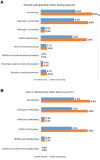Safety of cangrelor and transition to oral P2Y12 inhibitors in patients undergoing percutaneous coronary intervention: the ARCANGELO study
- PMID: 37646045
- PMCID: PMC10462400
- DOI: 10.1093/ehjopen/oead076
Safety of cangrelor and transition to oral P2Y12 inhibitors in patients undergoing percutaneous coronary intervention: the ARCANGELO study
Abstract
Aims: Cangrelor is the only intravenous P2Y12 inhibitor available. Safety, efficacy, and transitioning from cangrelor to oral P2Y12 inhibitors were recorded in patients with acute coronary syndrome (ACS). The ARCANGELO study aims to assess the safety of cangrelor on bleeding and the effects of the transition to oral P2Y12 inhibitors in a real-world setting according to the European Medical Agency's requirement.
Methods and results: Adult patients with ACS undergoing percutaneous coronary intervention (PCI) receiving cangrelor were included in the study. Patients were followed for 30 days. Incidence of bleeding events, major adverse cardiac events, and transition strategy to oral P2Y12 were recorded. Among 1004 ACS patients undergoing PCI, 995 (99.1%) were eligible for the analysis; 597 (60.0%) of them had ST-segment elevation myocardial infarction. A total of 925 (93.1%) patients underwent PCI by radial catheter access, and 972 (97.2%) received drug-eluting stents. All eligible patients received bolus and cangrelor infusion between 2 and 4 h in 95% of the cases. A total of 730 patients (73.4%) received ticagrelor, 127 (12.8%) prasugrel, and 138 (13.9%) clopidogrel as transition therapy. Bleeding, according to Bleeding Academic Research Consortium (BARC) criteria, within 30 days post-PCI occurred in 5.2% of patients (95% confidence interval: 3.9-6.8%); 0.5% experienced a moderate (BARC 3), and all others mild (BARC 1-2) bleeding events. Major adverse cardiac events occurred in 14 (1.4%) patients, principally all-cause mortality (n = 6 patients) and myocardial infarction (n = 7 patients).
Conclusion: The use of cangrelor in ACS patients undergoing PCI and the transition strategy to P2Y12 inhibitors are confirmed as safe and effective in daily practice.
Keywords: Acute coronary syndrome; Bleeding; Cangrelor; P2Y12 receptor inhibitor; Percutaneous coronary intervention.
© The Author(s) 2023. Published by Oxford University Press on behalf of the European Society of Cardiology.
Conflict of interest statement
Conflict of interest: All the activities were funded by Chiesi Farmaceutici S.p.A. (Parma, Italy).
Figures




Similar articles
-
Use of cangrelor in patients with acute coronary syndromes undergoing percutaneous coronary intervention: Study design and interim analysis of the ARCANGELO study.Clin Cardiol. 2022 Sep;45(9):913-920. doi: 10.1002/clc.23878. Epub 2022 Jun 22. Clin Cardiol. 2022. PMID: 35733352 Free PMC article.
-
Timing, indications and transition patterns associated with cangrelor use in patients undergoing PCI.J Thromb Thrombolysis. 2025 Aug 14. doi: 10.1007/s11239-025-03136-9. Online ahead of print. J Thromb Thrombolysis. 2025. PMID: 40813532
-
Platelet Inhibition With Cangrelor and Crushed Ticagrelor in Patients With ST-Segment-Elevation Myocardial Infarction Undergoing Primary Percutaneous Coronary Intervention.Circulation. 2019 Apr 2;139(14):1661-1670. doi: 10.1161/CIRCULATIONAHA.118.038317. Circulation. 2019. PMID: 30630341 Clinical Trial.
-
Efficacy and safety analysis of new P2Y12 inhibitors versus clopidogrel in patients with percutaneous coronary intervention: a meta-analysis.Curr Med Res Opin. 2015 Dec;31(12):2313-23. doi: 10.1185/03007995.2015.1098600. Epub 2015 Nov 4. Curr Med Res Opin. 2015. PMID: 26402735 Review.
-
Impact of new oral or intravenous P2Y12 inhibitors and clopidogrel on major ischemic and bleeding events in patients with coronary artery disease: a meta-analysis of randomized trials.Atherosclerosis. 2014 Apr;233(2):568-578. doi: 10.1016/j.atherosclerosis.2014.01.017. Epub 2014 Jan 21. Atherosclerosis. 2014. PMID: 24534451 Review.
Cited by
-
Antiplatelet Therapy for Elderly Patients with Acute Coronary Syndrome Undergoing Percutaneous Coronary Intervention.J Clin Med. 2024 Jul 19;13(14):4229. doi: 10.3390/jcm13144229. J Clin Med. 2024. PMID: 39064269 Free PMC article. Review.
-
Cangrelor in Patients Undergoing Percutaneous Coronary Intervention After Out-of-Hospital Cardiac Arrest.J Clin Med. 2024 Dec 27;14(1):76. doi: 10.3390/jcm14010076. J Clin Med. 2024. PMID: 39797159 Free PMC article.
-
Phenotyping the Use of Cangrelor in Percutaneous Coronary Interventions.Pharmaceuticals (Basel). 2025 Mar 19;18(3):432. doi: 10.3390/ph18030432. Pharmaceuticals (Basel). 2025. PMID: 40143208 Free PMC article. Review.
-
Pharmacodynamic effects of cangrelor in patients with acute or chronic coronary syndrome undergoing percutaneous coronary intervention: the POMPEII Registry.EuroIntervention. 2025 May 16;21(10):560-570. doi: 10.4244/EIJ-D-24-00757. EuroIntervention. 2025. PMID: 40375762
References
-
- Leonardi S, Mahaffey KW, White HD, Gibson CM, Stone GW, Steg GW, Hamm CW, Price MJ, Todd M, Dietrich M, Gallup D, Liu T, Skerjanec S, Harrington RA, Bhatt DL. Rationale and design of the cangrelor versus standard therapy to achieve optimal management of platelet inhibition PHOENIX trial. Am Heart J 2012;163:768–776.e2. - PubMed
-
- Angiolillo DJ, Fernandez-Ortiz A, Bernardo E, Alfonso F, Macaya C, Bass TA, Costa MA. Variability in individual responsiveness to clopidogrel. Clinical implications, management, and future perspectives. J Am Coll Cardiol 2007;49:1505–1516. - PubMed
-
- de Luca L, Leonardi S, Cavallini C, Lucci D, Musumeci G, Caporale R, Abrignani MG, Lupi A, Rakar S, Gulizia MM, Bovenzi FM, De Servi S. Contemporary antithrombotic strategies in patients with acute coronary syndrome admitted to cardiac care units in Italy: the EYESHOT Study. Eur Heart J Acute Cardiovasc Care 2015;4:441–452. - PubMed
-
- Gragnano F, Mehran R, Branca M, Franzone A, Baber U, Jang Y, Kimura T, Hahn JY, Zhao Q, Windecker S, Gibson CM, Kim BK, Watanabe H, Song YB, Zhu Y, Vranckx P, Mehta S, Hong SJ, Ando K, Gwon HC, Calabrò P, Serruys PW, Dangas GD, McFadden EP, Angiolillo DJ, Heg D, Valgimigli M; Single Versus Dual Antiplatelet Therapy (Sidney-2) Collaboration . P2y12 inhibitor monotherapy or dual antiplatelet therapy after complex percutaneous coronary interventions. J Am Coll Cardiol 2023;81:537–552. - PubMed
-
- Bhatt DL, Stone GW, Mahaffey KW, Gibson CM, Steg PG, Hamm CW, Price MJ, Leonardi S, Gallup D, Bramucci E, Radke PW, Widimský P, Tousek F, Tauth J, Spriggs D, McLaurin BT, Angiolillo DJ, Généreux P, Liu T, Prats J, Todd M, Skerjanec S, White HD, Harrington RA; CHAMPION PHOENIX Investigators . Effect of platelet inhibition with cangrelor during PCI on ischemic events. N Engl J Med 2013;368:1303–1313. - PubMed
LinkOut - more resources
Full Text Sources
Miscellaneous

